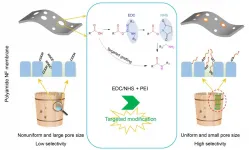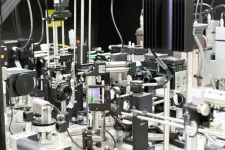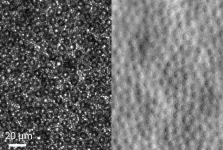New analysis of 2D perovskites could shape the future of solar cells and LEDs
2021-03-11
(Press-News.org) An innovative analysis of two-dimensional (2D) materials from engineers at the University of Surrey could boost the development of next-generation solar cells and LEDs.
Three-dimensional perovskites have proved themselves remarkably successful materials for LED devices and solar panels in the past decade. One key issue with these materials, however, is their stability, with device performance decreasing quicker than other state-of-the-art materials. The engineering community believes the 2D variant of perovskites could provide answers to these performance issues.
In a study published in The Journal of Physical Chemistry Letters, researchers from Surrey's Advanced Technology Institute (ATI) detail how to improve the physical properties of 2D perovskite called Ruddlesden-Popper.
The study analysed the effects of combining lead with tin inside the Ruddlesden-Popper structure to reduce the toxic lead quantity. This also allows for the tuning of key properties such as the wavelengths of light that the material can absorb or emit at the device level - improving the performance of photovoltaics and light-emitting diodes.
Cameron Underwood, lead author of the research and postdoctoral researcher at the ATI, said:
"There is rightly much excitement about the potential of 2D perovskites, as they could inspire a sustainability revolution in many industries. We believe our analysis of strengthening the performance of perovskite can play a role in improving the stability of low-cost solar energy and LEDs."
Professor Ravi Silva, corresponding author of the research and Director of the ATI, said:
"As we wean ourselves away from fossil energy sources to more sustainable alternatives, we are starting to see innovative and ground-breaking uses of materials such as perovskites. The Advanced Technology Institute is dedicated to being a strong voice in shaping a greener and more sustainable future in electronics - and our new analysis is part of this continuing discussion."
INFORMATION:
Note to editors
This research is sponsored by the EPSRC and the MUSICODE project.
ELSE PRESS RELEASES FROM THIS DATE:
2021-03-11
Recently, a research group led by Prof. WAN Yinhua from the Institute of Process Engineering (IPE) of the Chinese Academy of Sciences developed a novel targeted modification strategy to improve the separation selectivity of polyamide NF membranes.
The study was published in Journal of Membrane Science on March 10.
The low selectivity of commercial nanofiltration (NF) membranes to monosaccharides and monovalent salts is mainly due to the nonuniform pore size distribution and strong electronegativity.
Targeted modification can regulate the pore size distribution and electronegativity of polyamide NF membranes, and thus improve the separation selectivity.
In the strategy, carboxyl groups (-COOH) on the surface are activated by N-(3-Dimethylaminopropyl)-N'-ethyl ...
2021-03-11
An international collaboration headed by researchers from iPSYCH has found genetic variants that increase the risk of aggression in children with ADHD. In the same study, the researchers also discovered that the genetics which increase aggression in some children with ADHD, are the same genetics that affect aggression in children without a diagnosis.
For the first time, researchers have found positions in the genome that increase the risk of getting ADHD with disruptive behaviour disorders (DBDs). DBDs are child psychiatric disorders characterised by antisocial and ...
2021-03-11
Most new achievements in artificial intelligence (AI) require very large neural networks. They consist of hundreds of millions of neurons arranged in several hundred layers, i.e. they have very "deep" network structures. These large, deep neural networks consume a lot of energy in the computer. Those neural networks that are used in image classification (e.g. face and object recognition) are particularly energy-intensive, since they have to send very many numerical values from one neuron layer to the next with great accuracy in each time cycle.
Computer scientist Wolfgang Maass, together with his PhD student Christoph Stöckl, has ...
2021-03-11
The genetics of human eye colour is much more complex than previously thought, according to a new study published today.
An international team of researchers led by King's College London and Erasmus University Medical Center Rotterdam have identified 50 new genes for eye colour in the largest genetic study of its kind to date. The study, published today in Science Advances, involved the genetic analysis of almost 195,000 people across Europe and Asia.
These findings will help to improve the understanding of eye diseases such as pigmentary glaucoma and ocular albinism, where eye pigment levels play a role.
In addition, the team found ...
2021-03-11
Extremely preterm infants can suffer from a life-threatening inflammation of the gut. A new clinical study has shown that supplements of a lactic acid bacterium may have positive effects by increasing the diversity of intestinal bacteria in these infants. The study has been led by researchers at Linköping University, Sweden, and published in the scientific journal Cell Reports Medicine.
A litre of milk weighs a kilogram. Most infants who are born extremely prematurely weigh less than that. An infant who should have developed and grown for three more months in the protective environment of the mother's womb is, of course, extremely vulnerable. As a consequence of advances in neonatal care, many premature infants survive, although one out of four of the extremely ...
2021-03-11
Robots solving computer games, recognizing human voices, or helping in finding optimal medical treatments: those are only a few astonishing examples of what the field of artificial intelligence has produced in the past years. The ongoing race for better machines has led to the question of how and with what means improvements can be achieved. In parallel, huge recent progress in quantum technologies have confirmed the power of quantum physics, not only for its often peculiar and puzzling theories, but also for real-life applications. Hence, the idea of merging the two fields: on one hand, artificial intelligence ...
2021-03-11
Scientists have discovered a route of introduction for High Pathogenicity Avian Influenza Virus (HPAIV) H5N8 into Japan and, in parallel, have investigated the potential of two human anti-influenza drugs for the control of HPAI in birds.
Since October 30, 2020, there have been over 30 recorded outbreaks of High Pathogenicity Avian Influenza (HPAI) in domestic poultry and wild fowl in Japan. This outbreak was caused by the influenza A virus H5N8, a known High Pathogenicity Avian Influenza Virus (HPAIV). In such a scenario, identification of the source of the virus and its transmission route is important to control its spread.
A team of scientists led by Professor Yoshihiro Sakoda of Hokkaido University have recently found the probable route of introduction of ...
2021-03-11
WASHINGTON -- Researchers have developed a noninvasive technique that can capture images of rod and cone photoreceptors with unprecedented detail. The advance could lead to new treatments and earlier detection for retinal diseases such as macular degeneration, a leading cause of vision loss.
"We are hopeful that this technique will better reveal subtle changes in the size, shape and distribution of rod and cone photoreceptors in diseases that affect the retina," said research team leader Johnny Tam from the National Eye Institute. "Figuring out what happens to these cells before they are lost is an important step toward developing earlier interventions to treat and prevent blindness."
In Optica, The Optical Society's (OSA) journal for high impact research, the researchers show that ...
2021-03-11
A team led by scientists at the National Eye Institute (NEI) has noninvasively visualized the light-sensing cells in the back of the eye, known as photoreceptors, in greater detail than ever before. Published in Optica, the researchers report how they improved imaging resolution by a third by selectively blocking the light used to image the eye. NEI is part of the National Institutes of Health.
The achievement is the latest in an evolving strategy to monitor cell changes in retinal tissue that, in turn, will help identify new ways to treat and prevent vision loss from diseases such as age-related macular degeneration, a leading cause of blindness in people age ...
2021-03-11
DALLAS, March 11, 2021 -- Non-O blood type may increase the risk of stroke among women who smoke and take oral contraceptives, according to preliminary research to be presented at the American Stroke Association's International Stroke Conference 2021. The virtual meeting is March 17-19, 2021 and is a world premier meeting for researchers and clinicians dedicated to the science of stroke and brain health.
According to the most recent comprehensive data (January 2020) from the Centers for Disease Control and Prevention (CDC), stroke is the fifth leading cause of death in the United States and a major contributor to long-term disability. Some risk factors ...
LAST 30 PRESS RELEASES:
[Press-News.org] New analysis of 2D perovskites could shape the future of solar cells and LEDs




